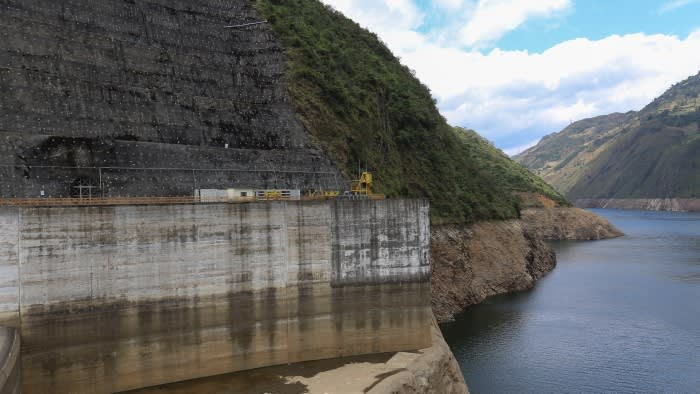Stay informed with free updates
Simply sign up to the Climate change myFT Digest — delivered directly to your inbox.
Historic droughts are rocking large parts of South America as energy grids powered by hydroelectric dams struggle to meet demand, and forest fires continue to spread in the stricken Amazon region.
The effects of global warming on the continent are intensifying extreme weather events, even as almost 200 countries gather over a fortnight for the UN COP16 biodiversity summit in the tropical city of Cali, Colombia.
Bogotá in Colombia, typically one of the world’s wetter capitals thanks to its altitude, has suffered scheduled daily water rationing for much of this year.
A study by an independent group of international scientists earlier this year found that climate change was the main cause of the exceptional drought in the Amazon Basin that has prevailed since 2023.
The basin stretches across the entire central and eastern area of South America, as far as Colombia in the north, Peru and Ecuador in the east, Guyana and Suriname to the west, and Brazil and Bolivia in the south.
The water shortages mean that Colombia has halted electricity exports to neighbouring Ecuador to protect its own supply.
Ecuador relies on hydropower for nearly 80 per cent of its energy, and the worst drought in six decades has led to strict electricity rationing across the nation. The capital, Quito, suffered scheduled daily blackouts of up to eight hours last week, with the prospect of these increasing to 14 hours a day next week.
Ecuador has contracted a barge-mounted 100MW power plant built by the Turkish firm Karpowership, though this barely covers 10 per cent of the national shortfall in demand of around 1,000MW.
The nation’s energy crisis, driven by drier reservoirs, is forecast to last until at least January. It could also have ramifications at next year’s polls where President Daniel Noboa will be standing for re-election. Earlier this month, he announced the interim replacement of energy minister Antonio Goncalves with Inés Manzano, who also holds the environment portfolio.
Cristian Paliz Acosta, a forecaster at INAMHI, the Ecuador government’s meteorological agency, attributed the unusually dry conditions to an intensification of the Walker circulation over the tropical Pacific, in which warm, moist air rises in the west while cold, dry air descends in the east.
“This strengthening is inhibiting the rains in South America and is delaying the appearance of other systems, which normally at this point of the year should already be occurring with more intensity,” Paliz said.
“That is why we have, at least in the last 30 days, accumulated percentages [of rainfall] that barely reach between 10 and 50 per cent in several areas of Latin America, Venezuela, Ecuador, in the Amazon areas, in Brazil.”
Parts of the Brazilian Amazon are suffering their worst drought on record, with key rivers, including tributaries of the Amazon river, falling to their lowest ever levels.
In the rainforest port city of Manaus, water levels earlier this month hit their lowest level since records began in 1902, breaking the previous record set only a year ago.
Much of the region’s river-borne transportation has been forced to a standstill, leaving remote villages isolated and short of supplies.
Below-average rainfall continued throughout the traditional rainy season this year, triggering a surge in the number of wildfires. These have burnt 10mn hectares in Bolivia and 7mn hectares in Brazil, according to the Inter-American Association for Environmental Defence (AIDA), and in turn caused extreme levels of pollution across swaths of the two countries in September.
Last month, Peru’s government declared a 60-day state of emergency in its Amazon provinces bordering Ecuador and Brazil, which have been the worst affected by forest fires.
Clair Barnes, researcher at the Grantham Institute, noted on the release of a recent report on the fires in the Amazon and the Pantanal wetlands: “The never-ending heat has combined with low rainfall to turn these precious ecosystems into highly flammable tinderboxes.”
Climate Capital
Where climate change meets business, markets and politics. Explore the FT’s coverage here.
Are you curious about the FT’s environmental sustainability commitments? Find out more about our science-based targets here
Source link : http://www.bing.com/news/apiclick.aspx?ref=FexRss&aid=&tid=6724967dad5c4f159a8154e7c74b4965&url=https%3A%2F%2Fwww.ft.com%2Fcontent%2Fed447a9d-eb3c-4709-b0ee-cf1f7b0a9667%3Fsharetype%3Dgift&c=3504165043507894953&mkt=en-us
Author :
Publish date : 2024-10-25 17:01:00
Copyright for syndicated content belongs to the linked Source.
